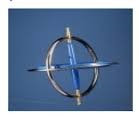How to make Gyro North Seeking?
The gyrospin hub can be made meridian-chasing (keeping up the turn hub parallel to the world's turn hub) by the utilization of a pendulum acting affected by earth gravity. The pendulum makes a power follow up on the gyro gathering making it precess. Precession, the second key property of a spinner, empowers the instrument to wind up north-chasing. As the pendulum swings towards the focal point of gravity, a descending power is connected to the wheel pivot, which makes even precession happen. This gravitational power acting descending on the spinner pivot makes the compass precess on a level plane and keep up the hub pointing towards genuine north.
The two principle methods for accomplishing precessional activity because of gravity are to make the gyro turn hub either base or best substantial.
Base overwhelming control and a clockwise pivoting gyro spinner are utilized by a few producers, while others support a Top-substantial control framework with an anticlockwise turning spinner.
Note :-
A marine gyro compass gathering is a cutting edge spinner intended to naturally discover land bearings. In spite of the fact that spinner is one vital part of a gyro compass, these are not similar gadgets; a gyro compass is worked to utilize the impact of gyroscopic precession, which is an unmistakable part of the general gyroscopic impact. Whirligig comprises of an impeccably adjusted wheel orchestrated to turn symmetrically at rapid around a hub or pivot. The wheel, or rotor, turns about its very own hub and, by suspending the mass in a correctly planned gimbals get together, the unit is allowed to move in two planes each at right edges to the plane of turn. There are along these lines three tomahawks in which the whirligig is allowed to move.
The turn hub.
The flat hub.
The vertical hub.
Essential Operation of free Gyroscope
A free whirligig has certain natural properties, one of which is dormancy, a marvel that can be straightforwardly identified with one of the essential laws of movement reported by Newton. Newton's first law of movement expresses that 'a body will stay in its condition of rest or uniform movement in a straight line except if a power is connected to change that state'. In this manner a turning mass will stay in its plane of revolution except if followed up on by an outer power. Thus the turning mass offers resistance to an outer power. This is called 'gyroscopic latency'
A gyrator rotor keeps up the heading of its plane of turn except if an outside power of adequate plentifulness to conquer dormancy is connected to adjust that course.
What are factors on which gyroscopic dormancy depend?
Gyroscopic inactivity relies on the energy of the turning rotor. The force of such a rotor relies on three fundamental components:
The all out mass, M of the rotor (for all particles).
The range r summed as the consistent K (for every one of the particles) where K is the sweep of gyration.
The precise speed.
Precession
Precession is the term used to depict the development of the hub of a spinner affected by an outer power. On the off chance that a power is connected to the rotor by moving one end of its hub, the spinner will be uprooted at an edge of 90° from the connected power.
What is controlled Gyroscope?
A free whirligig endures an evident development in both azimuth and tilt of the rotor hub relying on its latitudinal area. At the point when fitted to a vessel the scope is known and thus the degree of development in azimuth and tilt is likewise known. It is conceivable in this way to compute the important power required to deliver a complementary activity to address the impact of obvious development.
A power can be connected to the gyro that will cause both azimuth and tilt precession to happen contrary to the undesirable power brought about by the gyro's situation on the earth. On the off chance that the gyro is floating in azimuth at 'D' degrees every hour an anticlockwise way, an upward power adequate to cause clockwise precession at a rate of '– D' degrees every hour must be connected vertically to the fitting end of the rotor pivot. The outcome will be that the gyro float is dropped and the instrument focuses to a settled point on earth.
Gyro tilt development can likewise be dropped comparatively by applying an equivalent and inverse power on a level plane to the proper end of the rotor pivot.







0 comments: